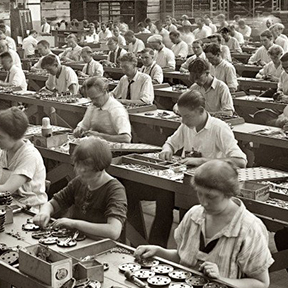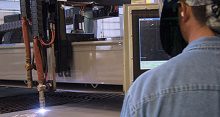
JERRY MALDONADO
Advisory Strategist
Welcome to the new age of the industrial revolution. Manufacturing is a hot topic again, undergoing the industry’s greatest change in more than 100 years. The age where the digital transformation of the manufacturing environment is essential for being competitive in today’s marketplace. As the creation of the assembly line transformed an era of the industrial boom, so has the emergence of digital technologies been a similar boom in today’s global economy.

As Professor Klaus Schwab has articulated in his book, The Fourth Industrial Revolution, “we are in the middle of another industrial revolution – our fourth.” The first industrial revolution occurred in the late 1700s with the advent of specialized machinery and factories, the second occurred during the early 20th century with Henry Ford introducing the assembly line and the third after World War II with the advent of computers and their computational prowess. As a result of these revolutions, products are manufactured faster and with a higher degree of consistency, and the products we are able to develop are increasingly complex and of greater value to consumers.
The industrial revolution we’re experiencing now, commonly referred to as Industry 4.0, is powered by technological advancements that include smart manufacturing, robotics, artificial intelligence and the Internet of Things (IoT) just to name a few items.
Technology has changed the landscape of how manufacturers go to market.
- How they build and produce marketable goods.
- How they bend and turn with demands of the consumer.
- How they have become more agile and efficient.
Technology provides manufacturers with the tools necessary to fulfill consumer expectations.
IoT / SCADA/ IIoT/ industry 4.0
The ability of machines to communicate and evolve to become a more intelligent device coupled with the advent of connected devices and platforms are driving digitization of the manufacturing arena. While the majority of manufacturing executives acknowledge the importance of this transformation, only a small percentage of them believe their current strategies are enough.

One of the biggest digital transformation topics in manufacturing today is the use of IoT. Internet of things, SCADA (the acronym for Supervisory Control and Data Acquisition), and Industrial Internet of things (IIoT) are transforming manufacturing by allowing for a connected experience that has streamlined and simplified many manufacturing processes. Since an IoT device can act as a control point and a data collector, these devices can provide real-time feedback and alerts that can inform operators of impending issues and/or defects in the product. In this simplest form, IoT devices reduce drastically cost and waste associated with the manufacturing process.
In my early days, I use to work in a machine shop that would make parts for cars and trucks. These parts were cut out of a block of metal with a drill motor. In those days you had to keep an eye on the color of the metal and the sound of the bit to determine if things were working right or not. If you let the drill get too hot, the end product would get discolored and have to be redone or recycled. If you didn’t change the drill bits often you stood the chance of cutting the material too roughly, and again ruining the end product. It took time and experience to get the feel of the machine and the materials, so production was slow. Today, for example, the same process is handled by a computer-controlled cutting machine or CNC (Computer Numerical Control) lathe that uses an enhanced drill bit with a heat sensor. This sensor provides feedback to the system as it trims and cuts the raw materials into the parts needed for the end product. This sensor provides feedback on temperature and drag on the drill bit, allowing the CNC machine to apply additional lubricant to keep the drill and material at the most efficient state possible. Now as stress increases and temperature increases, the intelligent software predicts a bit failure or notifies a mechanic that a bit is in need of sharpening or replacement. This automated step provides for the more efficient use of equipment, better control of operational uptime, and maintaining the condition of the part being manufactured to its optimum state, free of any heat or shear related stress due to the dull bit.
Interconnected Manufacturing Environment
Inter-machine communication can provide enhanced analytics during the assembly line process. It allows manufacturers to better control the supply chain, making sure that operations are not affected by raw-material or parts shortages. Concepts like just in time provisioning can be instituted such that large warehouses of raw materials are not needed or waste due to overstocked inventory should a slowdown in demand occur.
Industry 4.0 represents the vision of the interconnected manufacturing environment, where all equipment is online, and in some way is also intelligent and capable of making its own decisions. This standard represents the digitization of manufacturing. When equipment is connected, and data can flow and be analyzed, the entire manufacturing process can be changed.
Imagine for a second you are building widgets, there is a process to build a widget and a way to do it while making as much use of raw materials and equipment as possible. Consumers demand customization of the widget and look to organizations that can provide such customizations. A connected environment can help facilitate the additional steps for customization without impacting the main widget assembly line. For example, your widget needs a new nameplate added to it or you offer a custom feature for a widget. The extra step can be easily accommodated in the existing process either by the addition of another part or an update to one of the automated machines that produce the new widget. The result a flexible pipeline that can produce variations of the widgets and broaden the marketplace of the manufacturer for pennies on the dollar.
Connected devices allow for ease of automation and control.
- They allow for the sharing of data.
- Provide more intelligence on the assembly line or in the manufacturing process.
- Allow for data analytics to be captured and used to provide feedback, advanced notifications, state of health, and other forms of reporting to help improve the process throughout manufacturing operations.
- Connected devices allow for streamlined changes in real time.
With the inclusion of connectivity and IoT devices, smart manufacturing operations are creating the next industrial revolution or Industry 4.0. In future blogs, we will look into other technologies that are paving the way for this new industrial revolution.
Jerry Maldonado is currently an Advisor Strategist for VMware who specializes in helping customers move into the digital economy. Jerry provides insights into customer’s needs for the cloud, DevOps, IoT, IT operations and business strategy.
Jerry has over 30 years of hands-on and management experience in the technology industry and has architected and deployed some of the largest IT systems in the world. He has spoken at several events in North America as well as been seated at several roundtables and discussion panels on topics ranging from disaster recovery planning to virtualized systems in IT to advanced DevOps strategies and methodologies to modern cloud design and strategies.
Jerry holds degrees in Electromechanical Engineering and Computer Science and has numerous certifications with IBM, Microsoft, Computer Associates, Veritas, Legato, and others.
Jerry has been recognized by the Hispanic IT Executive Council as one of the top 100 Most Influential Hispanics In Technology.






